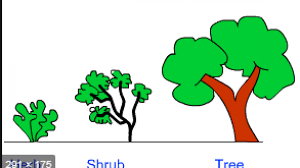what is the difference between herbs, shrubs, and trees?
A lot of people tend to think they know the differences between herbs, shrubs, and trees. But they cannot express them either in point or tabular form.
The lesson provides detailed insight into the difference between herbs, shrubs, and trees in a tabular form. Take time to listen to the comparison video for further insight.

What Are Herbs?
Herbs are non-woody and seed-producing plants. The leaves and roots of herbs tend to be medicinal. However, these plants tend to die after the end of their season.
Herbs have unbranched stems. They are further grouped as biennials, perennials, and annual herbs.
Biennials herbs take two years while perennial herbs more than two years to complete their life cycle. Annual herbs take one year only.
Examples of herbs are basil, lavender, culinary, and parsley among many others. These herbs are medicinal and aromatic.
What are Shrubs?
Shrubs are woody plants that contain several stems arising from the ground. The diameter of the stem is about 3 inches and they have a height of fewer than 13 feet.
Examples of shrubs are Witch hazel, roses, forsythia, lilacs, holly, and rose of Sharon, Fothergilla, Stewartstonian azalea, oakleaf hydrangea, red twig dogwood, King’s Gold, and Gold Mops.
What are Trees?
Trees are woody, perennial, and single trunk that grows to a considerate height. The lateral branches arise from the area above the ground.
The diameter of the trees tends to be about 3 inches. Trees are grouped as either angiosperms or gymnosperms.
The secondary growth experience by woody plants is due to the vascular cambium and the bark on trees is due to cork cambium.
You May Also Like: Difference Between Hydroponics and Aquaponics
Comparison Chart: Herbs vs Shrubs vs Trees
| Herbs | Shrubs | Trees |
| These are seed-producing non-woody plants | These are woody plants with several branches arising from the ground | These are woody perennial plants with a single trunk and grow at a considerable height. |
| Non-woody and soft stems | Woody and thick stems that are not hard | Woody plants with thick, hard and brown stems |
| Do not have branches | Have branches at the base | Have branches on a single stem |
| Tend to be short | Tend to be taller | Tend to be the tallest |
| Experience annual, biennial, or perennials growth patterns | Tend to be perennials | Tend to be perennials |
| Use as a food additive and medicine | Used in gardening and medicine | Prevent soil erosion, provide wood, and control carbon dioxide in the air |
| basil, lavender, culinary, and parsley | Witch hazel, roses, forsythia, lilacs, holly, and rose of Sharon | Pine and eucalyptus trees |
Core Differences between Herbs, Shrubs, and Trees
- Herbs are smaller than shrubs while trees are taller than shrubs
- Herbs have single stems, shrubs have multiple stems while trees have single trunk stem
- Herbs have delicate and thin tissues, shrubs have strong and soft tissues while trees have strong, thick, and hard tissues
- Herbs have no branches, shrubs have branches arising from the base while trees have branches arising above the ground
- Herbs add flavors to the food and medicinal purposes, shrubs are used for gardening while trees for wood production
- Trees are perennials, shrubs are perennial while herbs are annual, perennial, and biennials.
- Examples of herbs are Basil and Coriander, shrubs are Rose and Lemon plant while trees are Mango tree and Banyan tree.
Read More: Difference between Deciduous and Evergreen Forest
Similarities between Herbs, Shrubs, and Trees
- Both belong to kingdom Plantae
- The plant parts are differentiated into stems, roots, and leaves
- Both have vascular bundles
- Both produce seeds
Comparison Video
Summary
The core difference between herbs, shrubs, and trees is herbs are non-woody plants, shrubs are woody plants with delicate stems while trees have woody, hard and strong stems.